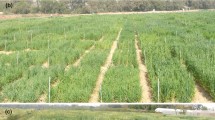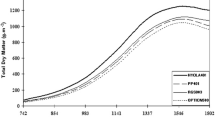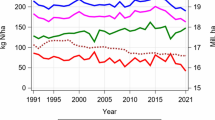Abstract
There is no information on whether N efficiency in canola at maturity can be reliably determined by screening germplasm in the vegetative stage. Twelve canola genotypes identified in preliminary screening study as having either high or low N efficiency indices were tested for consistency in N efficiency between the vegetative stage and maturity. Plants were grown in a glasshouse under low or adequate N supply and N efficiency was assessed using the following criteria: dry weight at deficient N supply, relative yield at low vs. adequate N supply, and N utilisation efficiency. None of the 12 tested genotypes was classified as efficient or inefficient under all three criteria. One genotype (46C74) was classified as efficient under two criteria, and one genotype (Surpass 300 TT) was inefficient under two criteria. At maturity, three additional efficiency criteria were used: harvest index, N harvest index, and oil and protein concentration in seed. Two genotypes (Wesway and 46C74) (ranked as efficient at vegetative stage) remained efficient at maturity under most of the efficiency criteria used. On the other hand, genotype Surpass 603 CL ranked inefficient during the vegetative stage was ranked as efficient at maturity under two criteria. Overall, there was little consistency in the N efficiency ranking between vegetative stage and maturity in 12 tested genotypes. Screening canola germplasm for N efficiency for breeding purposes would therefore require an assessment at maturity.








Similar content being viewed by others
References
Ahmad A, Khan I, Nasar AA, Yash PA, Iqbal M (2005) Role of sulphate transporter system in sulphur efficiency of mustard genotypes. Plant Sci 169:842–846
Anon (1979) Technicon Industrial Method 334-74 W/B+. Technicon Industrial Systems, Tarryown, NY, USA
Balint T, Rengel Z, Allen D (2008) Australian canola germplasm differs in nitrogen and sulphur efficiency. Aust J Agric Res 59(2):167–174
Brennan RF, Mason MG, Walton GH (2000) Effects of nitrogen fertilizer on the concentration of oil and protein in canola (Brassica napus) seed. J Plant Nutr 23:339–348
Carmody P, Walton G (2003) A decade of development for the canola industry in Western Australia. In: Proceedings of the 11th International Rapeseed Congress, Copenhagen, Denmark. pp EO1: economics
Chamoro AM, Tamagno LN, Bezus R, Sarandon J (2002) Nitrogen accumulation, partition, and nitrogen use-efficiency in canola under different nitrogen availabilities. Commun Soil Sci Plant Anal 33:493–504
Fageria NK, Baligar VC (1997) Phosphorus-use efficiency by corn genotypes. J Plant Nutr 20:1267–1277
Grami B, La Croix LJ (1977) Cultivar variation in total nitrogen uptake in rape. Can J Plant Sci 57:619–624
Hocking PJ, Randall PJ, DeMarco D (1997) The response of dryland canola to nitrogen fertilizer: partitioning and remobilization of dry matter and nitrogen, and nitrogen effects on yield components. Field Crops Res 54:201–220
Holmes MRJ (1980) Nutrition of the Oilseed Rape Crop. Applied Science Publisher, London, UK
Kessel B, Becker HC (1999) Genetic variation of nitrogen-efficiency in field experiments with oilseed rape (Brassica napus L.). In: Gissel-Nielsen G, Jensen A (eds) Plant nutrition—molecular biology and genetics. Kluwer Academic Publishers, Dordrecht, The Netherlands, pp 391–395
Lynch J (1998) The role of nutrient-efficient crops in modern agriculture. J Crop Prod 1:241–264
Maman N, Mason SC, Galusha T, Clegg MD (1999) Hybrid and nitrogen influence on pearl millet production in Nebraska: Yield, growth, and nitrogen uptake, and nitrogen use efficiency. Agron J 91:737–743
Mason MG, Brennan RF (1998) Comparison of growth response and nitrogen uptake by canola and wheat following application of nitrogen fertilizer. J Plant Nutr 21:1483–1499
Mollers C, Bolune T, Wallbraun M, Lohaus G (1996) Protein content and amino acid composition of the seeds and the phloem sap of one Brassica carinata and different B. napus L. genotypes. In: Proceedings of the Symposium Breeding for Oil and Protein Crops, Zaporozhye, Ukraina, pp 148–154
Moore G (1998) Soil guide: a handbook for understanding and managing agricultural soils. Bull. 4243.. Agriculture Western Australia, Perth, Western Australia, Australia
Northcote KH (1971) A factual key for the recognition of Australian soils. Rellim Glenside, SA
Osborne LD, Rengel Z (2002) Screening cereals for genetic variation in efficiency of phosphorus uptake and utilization. Aust J Agric Res 53:295–303
Pluske WM, Osborne LD (2001) Canola symptoms of nutrient deficiency. Westfarmers CSBP Ltd, Kwinana WA
Pritchard FM, Eagles HA, Norton RM, Salisbury PA, Nicolas M (2000) Environmental effects on seed composition of Victorian canola. Aust J Exp Agric 40:679–685
Rengel Z (1999) Physiological mechanisms underlying differential nutrient efficiency of crop genotypes. In: Rengel Z (ed) Mineral Nutrition of Crops: Fundamentals Mechanisms and Implications. The Haworth Press, Binghamton, New York, pp 227–265
Rengel Z (2001) Genotypic differences in micronutrient use efficiency in crops. Commun Soil Sci Plant Anal 32:1163–1186
Rengel Z, Graham RD (1995) Wheat genotypes differ in Zn efficiency when grown in chelate-buffered nutrient solution. Plant Soil 176:307–316
Rengel Z, Hawkesford MJ (1997) Biosynthesis of a 34-kDa polypeptide in the root-cell plasma membrane of a Zn-efficient wheat genotype increases upon Zn deficiency. Aust J Plant Physiol 24:307–315
Rossato L, Laine P, Ourry A (2001) Nitrogen storage and remobilization in Brassica napus L. during the growth cycle: nitrogen fluxes within the plant and changes in soluble protein patterns. J Exp Bot 52:1655–1663
Schjoerring JK, Bock JGH, Gammelvind L, Jensen CR, Mogensen VO (1995) Nitrogen incorporation and remobilization in different shoot components of field-grown winter oilseed rape (Brassica napus L.) as affected by rate of nitrogen application and irrigation. Plant Soil 177:255–264
Seiffert B, Ecke W, Lohaus G, Wallbraun M, Zhou Z, Mollers C (1999) Strategies for the investigation of N-efficiency in oilseed rape. In: Gissel-Nielsen G, Jensen A (eds) Plant nutrition—molecular biology and genetics. Kluwer Academic Publishers, Dordrecht, Netherlands, pp 425–432
Siddiqi KY, Glass ADM, Ruth TJ, Fernando M (1989) Studies of the regulation of the nitrate influx by barley seedlings using 13NO3 −. Plant Physiol 90:806–811
Svecnjak Z, Rengel Z (2006) Canola cultivars differ in nitrogen utilization efficiency at vegetative stage. Field Crops Res 97:221–226
Yau SK, Thurling N (1987) Variation in nitrogen response among spring rape (Brassica napus) cultivars and its relationship to nitrogen uptake and utilization. Field Crops Res 16:139–155
Yuen SH, Pollard AG (1954) Determination of nitrogen in agricultural materials by the Nessler reagent. II. Micro-determination in plant tissue and in soil extracts. J Sci Food Agric 5:364–369
Zapata F (1990) Isotope techniques in soil fertility and plant nutrition studies. In: Use of nuclear techniques in studies of soil-plants relationships, International Atomic Energy Agency, Vienna, pp 61–129
Acknowledgements
We would like to thank Dr Zlatko Svecnjak for stimulating discussion and advice. The canola seed was contributed by Department of Agriculture and Food Western Australia (South Perth and Northam), Canola Breeders Western Australia (Shenton Park) and Australian Temperate Field Crops Collection (Horsham). The financial support from the Australian Research Council is gratefully acknowledged.
Author information
Authors and Affiliations
Corresponding author
Rights and permissions
About this article
Cite this article
Balint, T., Rengel, Z. Nitrogen efficiency of canola genotypes varies between vegetative stage and grain maturity. Euphytica 164, 421–432 (2008). https://doi.org/10.1007/s10681-008-9693-6
Received:
Accepted:
Published:
Issue Date:
DOI: https://doi.org/10.1007/s10681-008-9693-6




